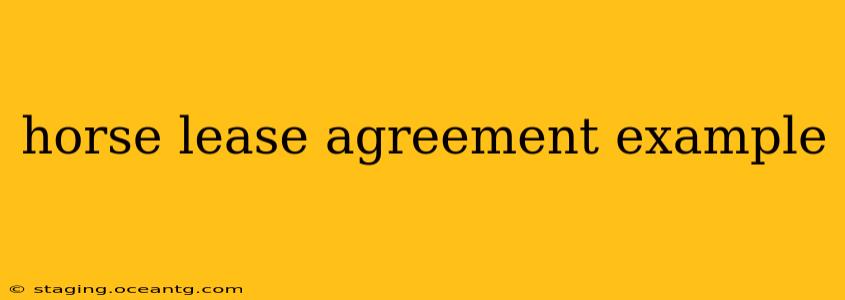Finding the perfect horse can be exhilarating, but ensuring a smooth and legally sound arrangement is crucial. A well-written horse lease agreement protects both the owner and the lessee, outlining responsibilities, expectations, and contingencies. This comprehensive guide provides a sample horse lease agreement and explores key considerations for a successful partnership.
What is a Horse Lease Agreement?
A horse lease agreement is a legally binding contract between a horse owner (lessor) and a person who wants to use the horse (lessee). It details the terms of the lease, including the duration, payment, responsibilities for care, and what happens in case of injury or death of the horse. Think of it as a detailed rental agreement specifically for horses. A well-structured agreement prevents misunderstandings and protects both parties involved.
Key Components of a Horse Lease Agreement Example
A comprehensive horse lease agreement typically includes the following elements:
1. Parties Involved: Clearly identify the owner (lessor) and the person leasing the horse (lessee), including their full legal names and addresses.
2. Description of the Horse: Provide a detailed description of the horse, including its name, breed, age, color, markings, and any identifying characteristics (branding, microchip number).
3. Lease Term: Specify the start and end dates of the lease. This could be a fixed period (e.g., one year) or a month-to-month arrangement.
4. Lease Fee: Clearly state the amount of the monthly or yearly lease payment, the payment method (check, electronic transfer), and the due date. Consider including a late payment fee clause.
5. Responsibilities of the Lessee: This is a crucial section, detailing the lessee's obligations. Examples include:
- Care of the Horse: This should specify the lessee's responsibility for feeding, watering, grooming, exercising, and providing veterinary care.
- Farrier and Veterinary Services: Who is responsible for scheduling and paying for farrier and veterinary services? Will the owner have input?
- Boarding: Specify where the horse will be boarded and who is responsible for the boarding fees.
- Insurance: Will the lessee be required to carry liability insurance?
- Riding: Are there any restrictions on how the horse may be ridden (e.g., only for pleasure riding, no jumping)?
- Transportation: Who is responsible for transportation costs associated with the horse?
6. Responsibilities of the Lessor: The owner's responsibilities should also be clearly outlined. This might include:
- Providing initial veterinary records: Sharing the horse's complete health history.
- Access to the horse: Ensuring the lessee has access to the horse as agreed upon.
- Major Veterinary Expenses: Defining who is responsible for major veterinary expenses, such as colic surgery. Often, a shared responsibility or a pre-agreed financial limit is established.
7. Termination Clause: This section details the conditions under which the lease can be terminated by either party. Include reasons for termination, notice periods, and procedures for returning the horse.
8. Liability: This critical section addresses liability in case of injury to the lessee, other persons, or the horse itself. Consider consulting with a legal professional to ensure adequate protection for both parties.
9. Dispute Resolution: This section outlines a process for resolving disagreements that may arise during the lease. This could involve mediation or arbitration.
10. Entire Agreement: This clause states that the written agreement constitutes the entire agreement between the parties, superseding any prior agreements or understandings.
Frequently Asked Questions (FAQs)
What happens if the horse gets injured during the lease?
This should be clearly detailed in the agreement. It often involves shared responsibility for veterinary costs, with a possible cap on the lessee's financial obligation for significant injuries.
Can I sublease my leased horse?
Generally, no, unless explicitly permitted within the lease agreement. Subleasing without permission is a breach of contract.
What if I want to end the lease early?
The lease agreement will specify the terms for early termination, including potential penalties.
Do I need a lawyer to draft a horse lease agreement?
While not strictly required for a simple lease, consulting an attorney specializing in equine law is highly recommended, especially for more complex situations. A lawyer can ensure the agreement protects your interests and complies with all relevant laws.
Where can I find a sample horse lease agreement?
Numerous sample agreements are available online; however, remember that these are templates and may not be suitable for all situations. A customized agreement is always best.
This example offers a framework for a horse lease agreement. It's essential to remember that this is not a substitute for professional legal advice. Consult with an attorney to create a legally sound and comprehensive agreement tailored to your specific circumstances. A well-drafted agreement protects both the horse owner and the lessee, ensuring a positive and productive partnership.
